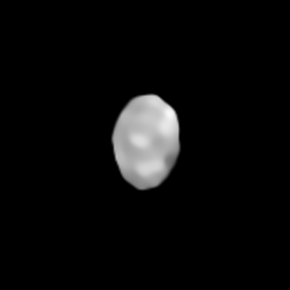
Back 16 Psyche Afrikaans (16) Psyche ALS 16 سايكي Arabic سايكي 16 ARZ 16 Psyche AST (16) Псіхея Byelorussian 16 Психея Bulgarian ১৬ সাইকি Bengali/Bangla (16) Psique Catalan (16) Психея CE
 16 Psyche imaged by the Very Large Telescope's adaptive optics system in August 2019 | |
| Discovery | |
|---|---|
| Discovered by | Annibale de Gasparis |
| Discovery site | Naples Observatory |
| Discovery date | 17 March 1852 |
| Designations | |
Designation | (16) Psyche |
| Pronunciation | /ˈsaɪkiː/[1] |
Named after | Psyche (Ψυχή) |
| Main belt | |
| Adjectives | Psychean (/saɪˈkiːən/)[2] |
| Symbol | |
| Orbital characteristics[3] | |
| Epoch 13 September 2023 (JD 2460200.5) | |
| Aphelion | 3.32 AU (497 million km) |
| Perihelion | 2.53 AU (378 million km) |
| 2.92 AU (437 million km) | |
| Eccentricity | 0.1342 |
| 4.999 yr (1825.95 d) | |
| 243.16° | |
| Inclination | 3.096° |
| 150.03° | |
| 27 April 2025 | |
| 229.41° | |
| Earth MOID | 1.53 AU (229 million km) |
| Physical characteristics | |
| Dimensions | (278±5 × 232±6 × 164±4) km[4] 277 km × 238 km × 168 km[4][a] 279 × 232 × 189 km (± 10%)[5] (278+4 −8 × 238+4 −6 × 171+1 −5) km[6] |
Mean diameter | 223±3 km[7] 222±4 km[4] 222+1 −4 km[6] |
| Flattening | 0.41[b] |
| Volume | 5.75×106 km3 (best fit)[6] |
| Mass | (2.29±0.14)×1019 kg[8] |
Mean density | 3.977±0.253 g/cm3 |
| ~0.144 m/s2[5] | |
| ~180 m/s[5] (~600 ft/s) | |
| 4.195948±0.000001 h[5][6] | |
| Albedo | 0.15±0.03[4] 0.34±0.08 (radar)[6] |
Spectral type | Tholen = M[3] SMASS = X[3] Bus-DeMeo = Xk[9] |
| 9.22 to 12.19 | |
| 6.21[3] | |
16 Psyche (/ˈsaɪkiː/ SY-kee) is a large M-type asteroid, which was discovered by the Italian astronomer Annibale de Gasparis, on 17 March 1852 and named after the Greek goddess Psyche.[10] The prefix "16" signifies that it was the sixteenth minor planet in order of discovery. It is the largest and most massive of the M-type asteroids, and one of the dozen most massive asteroids. It has a mean diameter of approximately 220 kilometers (140 mi) and contains about one percent of the mass of the asteroid belt. It was thought to be the exposed core of a protoplanet,[11] but recent observations cast doubt on that hypothesis.[8][6] Psyche will be explored by NASA, with a spacecraft of the same name, marking the first time a manmade object will journey to a metallic asteroid, launched on 13 October 2023,[12] with an expected arrival in 2029.[13]
- ^ Cite error: The named reference
Webster-1884was invoked but never defined (see the help page). - ^ Cite error: The named reference
OED-Psycheanwas invoked but never defined (see the help page). - ^ a b c d Cite error: The named reference
JPLwas invoked but never defined (see the help page). - ^ a b c d Cite error: The named reference
Ferrais-Vernazza-etal-2020was invoked but never defined (see the help page). - ^ a b c d Cite error: The named reference
Shepard-Richardson-etal-2017was invoked but never defined (see the help page). - ^ a b c d e f Cite error: The named reference
Shepard2021was invoked but never defined (see the help page). - ^ a b Cite error: The named reference
Vernazza2021was invoked but never defined (see the help page). - ^ a b Cite error: The named reference
Elkins-Tanton_2020was invoked but never defined (see the help page). - ^ Cite error: The named reference
PDS-taxonomywas invoked but never defined (see the help page). - ^ Cite error: The named reference
Schmadel-2012-dict-mpwas invoked but never defined (see the help page). - ^ Cite error: The named reference
Bell_AsteroidsIIwas invoked but never defined (see the help page). - ^ Cite error: The named reference
Lockhart-2023-09-28was invoked but never defined (see the help page). - ^ "NASA Continues Psyche Asteroid Mission". JPL. NASA. 28 October 2022. Archived from the original on 8 November 2022. Retrieved 28 October 2022.
Cite error: There are <ref group=lower-alpha> tags or {{efn}} templates on this page, but the references will not show without a {{reflist|group=lower-alpha}} template or {{notelist}} template (see the help page).
© MMXXIII Rich X Search. We shall prevail. All rights reserved. Rich X Search